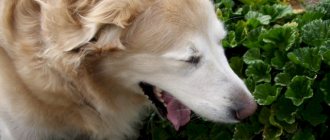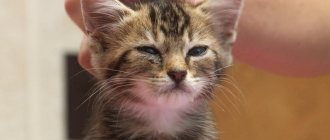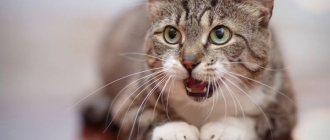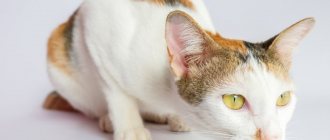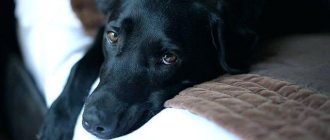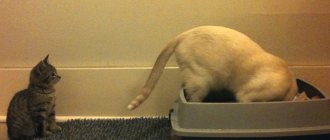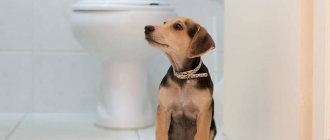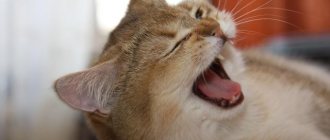Sneezing – this is a protective reaction of the body, with the help of which the dog removes various pathogenic microorganisms, mucus and foreign particles from the nasopharynx. Sneezing and snorting in a dog is not a mandatory symptom of any disease, but if the dog sneezes too often, and even more so if additional symptoms of the disease appear, then the cause of this phenomenon should be identified as soon as possible and eliminated. A lot of things can cause sneezing, and it’s worth considering the most common ones.
Causes of sneezing in dogs
Sneezing in a dog can cause:
- Hypothermia of the body.
- Rhinitis.
- Infection.
- Allergy.
- Injury.
- Heart diseases.
- Foreign body.
If your dog sneezes during a walk, do not rush to sound the alarm; single sneezes are quite acceptable. Everyone knows that a dog smells everything, as a result of which dust, earth, seeds or pollen, etc. often end up in the dog’s nose. If a dog’s sneezing becomes frequent and other symptoms are added, the dog’s owner will need to figure out why the dog is sneezing, whether there is any disease, and whether it is worth taking the dog to a veterinary clinic.
Treatment
Treatment should be prescribed by a veterinarian after an in-person examination of the dog.
Because in order to take action for the dog’s recovery, it is necessary to determine the cause of the disease, and this is not always possible at home.
What to do before visiting the clinic?
First, examine your nasal passages. It is advisable to use a flashlight to illuminate your nose. This way you can detect foreign objects if there are any. Also, you will immediately see if there is swelling and redness; these are the first signs of inflammation.
Remove dirt and crusts around the nose using a cotton pad moistened with plain warm water.
To reduce inflammation, it is safe to use Anandin drops or a 0.15% Maksidin solution, one drop in each nostril. These drops are a complex preparation against bacteria. Helps relieve swelling and promotes tissue healing.
If after a couple of days the sneezing does not go away, does not become weaker, and the dog exhibits other symptoms - lethargy, loss of appetite, fever, you should immediately consult a doctor. There is always a danger that the dog has contracted a viral infection, which is very dangerous for the pet’s life!
Entry of foreign bodies into the nasal cavity
While walking, dogs explore with their noses everything they encounter along the way. If your dog, while walking, starts snorting and sneezing, waving his head, or rubbing his nose with his paw, then there is a high probability that something has gotten into his nose. There may be blood and copious mucous discharge from the nose. In such a case, the dog owner urgently needs to examine its nose and try to remove any foreign objects with tweezers. If this cannot be done, the dog must be urgently taken to a veterinary clinic to remove foreign objects from the nasal cavity.
Prescription procedure for sneezing of any origin
Treatment for a dog with symptoms (sneezing and snorting) depends on the cause. If a pet exhibits a similar reaction to external substances (gases, smoke, allergens), it is enough to eliminate the negative factor and the sneezing will stop.
If infectious pathologies, lung diseases, or allergic reactions are detected, appropriate conservative therapy is prescribed. Upon recovery, the dog will stop sneezing.
For foreign objects in the nasal sinuses, an endoscope (rhinoscope) is used and they are removed under anesthesia. Neoplasms (polyps) are also removed surgically, with the exception of inoperable malignant forms that have “grown” into the nasal septum. In this case, it is surgically impossible to perform resection without deforming the skull.
Hypothermia of the body
With a sudden change in ambient temperature, when there is a sharp narrowing or expansion of the blood vessels of the nasal cavity, the dog may begin to sneeze. Most often, dog owners notice this phenomenon in winter, when they return from a walk to a warm apartment, or vice versa, when a dog leaves a warm apartment in the cold.
This is a normal physiological reaction of the body and should not bother the owner. For those dog breeds that have a small coat of hair, in order to prevent hypothermia in the winter, owners must purchase special clothing for walking.
Nowadays, with the abundance of various clothes for dogs, for dogs with short hair, walking without clothes in cold weather is considered wrong. Therefore, if you want to take a walk with your dog in winter, you need to purchase a so-called “dog coat” or avoid walking in cold weather.
The opinion of some owners that the nature of the dog has provided for everything in this regard is considered completely wrong. This is true for those dogs who live in summer cottages, in rural areas in their kennels on the street. In large metropolitan areas, most dog owners keep them in their warm apartment. Dogs living on the street and in apartments react differently to the cold.
If after a walk you notice that your pet has begun to sneeze, cough, is chilling and is trying to find a warmer place in the apartment, then this indicates that the dog has suffered from hypothermia.
With severe hypothermia, the visible mucous membranes become pale, and sometimes blisters appear on the pads, tips of the ears and genitals (2nd degree frostbite). The dog's body temperature begins to decrease.
In this situation, you will need to take care of your pet by providing it with “dry warmth” - wrap it in a blanket, place a heating pad on the paw area and contact a veterinarian for advice by phone.
Prevention methods
The dog should not be kept in a dusty room or in places where there are strong chemical odors. It is not recommended to smoke or use sprayed fragrances or concentrated perfumes in the house. A dog's sense of smell is several times better than a human's, and where the owner thinks it smells normal, the animal's nasal mucosa is irritated.
Be sure to prevent infectious pathologies, helminthiasis, rhinitis, etc. Periodically inspect the mouth for caries and gum pathology.
If your dog begins to sneeze or snort frequently, there are discharges from the nostrils, or other symptoms of illness are present - do not hesitate! Call the RosVet VC by phone, 24 hours a day. Make an appointment with your veterinarian or call a specialist to your home. The clinic receives visitors 24 hours a day.
Rhinitis or runny nose
Rhinitis in dogs is accompanied by sneezing. In dogs, at the beginning of the disease, colorless snot appears, which has a liquid consistency, later its consistency becomes thicker. The dog tries to wipe its nose with its paws and often licks itself. As the disease progresses, the dog's nasal discharge will become thicker, causing crusts to form in the nose, making it difficult for the dog to breathe, causing the dog to sniffle and sometimes breathe through the mouth. Mixed dyspnea may occur in some dogs. The nasal mucosa is reddened. If rhinitis is an independent disease, then there are no changes in the general condition of the dog’s body, and the dog retains a good appetite. For more details, see our article - runny nose in dogs.
Reverse sneeze syndrome
It looks as if the dog is sneezing into itself, while the dog sometimes takes an unnatural pose and the sounds that the animal makes at the same time resemble an asthmatic attack. This picture often frightens the owner, but most often does not pose any danger to the dogs.
If after an attack the pet behaves as usual, the appetite and temperature are normal, then there is no need to worry.
A reverse sneezing attack can be caused by stress, a tight collar, inhalation of caustic substances, and some other factors.
This process is a spasm of the larynx. Representatives of brachycephalic breeds are especially prone to this due to the characteristics of their deformed skull.
Allergy
Dogs see the world around them mostly through their nose; dogs have a highly developed sense of smell (smell in dogs). In modern life, when in recent decades a large number of artificial odors have appeared, plus an additionally extremely difficult environmental situation, especially around large cities, dogs with allergies, like people with allergies, are not uncommon.
The following can serve as an allergy agent for dogs:
- Household chemicals (washing powder, deodorants), perfumes, perfumes, etc.
- Pollen is a strong allergen for dogs; in the spring, dogs often develop seasonal allergies to certain plants.
- Mold.
- Dust, including from carpets, books, etc.
- Tobacco smoke, especially when the owners are non-smokers, and on the street (at the entrance) you and your dog pass by a smoking person.
- In summer, dogs are often susceptible to allergies as a result of insect bites; a dog bite from a snake is especially dangerous.
- The use of a flea collar may cause allergies in some dogs.
- Often the source of allergies is dog food (food allergies in animals).
Allergy symptoms in dogs are accompanied by constant sneezing, watery eyes, coughing, snot, and skin itching (itching in dogs).
If your dog develops an allergy, you need to urgently contact your veterinary clinic, where veterinary specialists will determine the cause of the allergy and prescribe appropriate treatment and give recommendations on feeding and keeping the dog.
Briefly about the main thing
- The causes of sneezing can be: allergies, infection, foreign body, local irritation, trauma, neoplasm, parasites, frontal sinusitis, stress.
- Reverse sneezing syndrome can sometimes be observed in dogs. It may look scary, but unless there are other accompanying symptoms, there is often no need to worry.
- At risk are pets with weakened immune systems and those that are often exposed to drafts and are exposed to hypothermia. As well as representatives of brachycephalic breeds.
- Treatment should be prescribed by a veterinarian after determining the cause.
- For prevention, it is necessary to vaccinate the animal in a timely manner, treat it against parasites and provide the dog with a warm “place” without drafts.
Sneezes and grunts
Grunting is a typical sound made by Mastiffs, Bulldogs and related breeds (even Pugs and Pekingese). The reason is the special structure of the muzzle and respiratory apparatus. But if grunting is accompanied by coughing, shortness of breath and sneezing, this is a reason to visit the veterinarian.
Such reflexes are the cause of helminthic infestation. Roundworms settle not only in the intestines, but also live throughout the body. If the pet is restless, often vomits, scratches the anal passage, while sneezing and grunting, then there is only one conclusion - infection with helminths. Routine cleaning should be carried out using the usual preparations.
A deadly pathology is tracheal collapse (softening of the cartilaginous rings of the trachea, blocking of the larynx, lowering the softening process to the bronchi). The disease is genetic and incurable.
Sneezing and coughing are not a reason to panic. If such attacks occur regularly, the owner knows what causes them and how to get rid of them, then there is no point in going to the clinic. But if the pathology is primary, then it is better to contact a veterinarian to find out the cause.
Lack or partial loss of appetite combined with weakness of the pet
Your Alabai has had some difficult days. The text of the message indicates that anthelmintic treatment was carried out with the drug "Brovanol-plus", then vaccination. It is known that the interval between taking an anthelmintic and vaccination is at least three weeks. We emphasize that Brovanol-plus is a strong medicine. The dose calculated by the doctor or owner (one tablet per four kilograms of weight) should be divided into two parts and given with a break of a day. If the conditions are not met, the dog finds itself in extremely difficult survival conditions - there is no other way to put it.
Taking a break while taking the medicine helps the body cope with the poisoning. An anthelmintic is always a small dose of poison. It is important to calculate the dose correctly. Taking a full dose of medication at once can put your dog in a state similar to food intoxication. The dog eats little or stops eating within one or two days. Able to simply lie in a corner without reacting to the owner’s approach. There is an inhibited reaction to any stimulus and decreased muscle tone.
When an animal has not eaten enough, problems occur during bowel movements. Even with normal drinking water, constipation occurs. If you do not wait for the restoration of good health and add an antibiotic, the disorder becomes more pronounced. By adding Vaseline oil, difficulties with bowel movements are not immediately resolved.
Take a break of three to four weeks after taking anthelmintic tablets before vaccination to provide all possible assistance to the animal. A pet's weakened body, when receiving a dose of vaccine, is rarely able to withstand such an attack. As a reaction, a loss or decrease in appetite is possible, the pet becomes lethargic and sad.
Providing first aid to a pet
Nosebleeds often occur spontaneously, causing normally anxious owners to panic. In order not to harm your pet and quickly stop the bleeding, you should adhere to the following algorithm:
- do not panic - the owner’s panic is transmitted to the pet, and anxiety leads to an increase in the dog’s blood pressure. As a result, blood loss will increase, regardless of the measures taken;
- the dog sits down with its head tilted down. This position will prevent blood from entering the animal’s throat and will not interfere with breathing through the mouth;
- A compress is placed on the back of the nose using ice cubes wrapped in gauze. If there is no ice, you can use something from the refrigerator (a bottle of cool water);
- conduct an examination - after first aid is provided, the dog must be examined. You should wipe your face with a damp towel, removing traces of blood, and examine the bridge of the nose and nasal passages for swelling and foreign bodies. If the problem is known, then you can alleviate the pet’s condition yourself - remove the splinter, treat the wound, etc.
Important! Manipulations are allowed if the owner is absolutely sure of the correctness of the actions being performed. If in doubt, it is better to trust the doctor.
If the dog is overly excited, it is prohibited:
- treat the dog with sedatives;
- make sudden movements to change the dog’s position;
- rinse your nose;
- remove foreign bodies yourself.
It is important to see a doctor quickly. He will recommend an examination and prescribe treatment.
Colds
If your dog sneezes frequently, it may have a cold. Coughing, sneezing, fever, lacrimation are the main symptoms of infectious and colds. If the virus affects the mucous membrane of the stomach and intestines, vomiting and diarrhea (stomach flu) may occur.
There is a high risk of disease during seasonal epidemics, especially if the dog is walked for a long time without special clothing during the cold season. At the same time, there are sneezing fellow tribesmen in the dog park, which makes infection inevitable. The main provoking factor for infectious diseases is the dog’s low immunity.
It is possible to avoid infection by following preventive measures:
- limit walking during epidemics (time spent on the street should not exceed 30 minutes);
- in cold weather, dress your pet in special dog clothes;
- Vaccinate it regularly (the first vaccination is done immediately after the end of the period of teeth change).
Infectious diseases are fraught with serious complications. The most dangerous of them are pneumonia, plague and leptospirosis.
Causes of the disease
Seeing that the dog is sneezing, the owners wonder what to do? There are different reasons for sneezing. Methods of providing medical care to an animal in each specific case must be selected individually.
Here are the most common reasons:
- entry of foreign bodies into the nose and nasopharynx;
- injury to the mucous membrane of the upper respiratory tract;
- entry of irritating substances into the respiratory tract;
- polyps or tumors of the nasal and nasopharyngeal mucosa;
- allergic reactions;
- colds and infectious diseases;
- hypothermia of the body;
- heart problems.
Do I need to contact a veterinarian?
Excessive blood loss is fraught with serious consequences, so do not neglect the help of a veterinarian. Even a small leak can accompany a dangerous systemic disease, so do not make hasty conclusions until the diagnosis is established.
Diagnosis at home or in clinic
Before contacting the veterinary clinic, try to collect as much information as possible about what happened. Record all alarming symptoms, analyze the likelihood of injury and poisoning, and do not forget to take with you the instructions for all medications your pet takes.
Remember that one of the most alarming signs is paleness of the mucous membranes, which can lead to death from excessive blood loss. In such a situation, you should seek help even at night, without thinking about making an appointment in advance. Four-legged patients in serious condition are always accepted without a queue.
If you were unable to stop the bleeding, and your pet’s condition continues to worsen, do not waste time on the road and call a doctor directly to your home. If there is a serious threat to the dog’s life, they may be taken to the hospital.
Sneezes and snorts
Snorting is a sign that your pet is trying to clear his sinuses . If the lobe is clean and there is no discharge, then the cause lies in a foreign object. In this case, a prolonged act of sneezing and other symptoms are noted:
- Anxiety (the dog rubs its nose with its paws);
- Difficulty breathing (the dog cannot draw in air and snorts);
- Coughing attacks are possible when the posterior connective tissue is blocked.
If your dog is sneezing heavily for several days, there is a reason to see a veterinarian. A single or double sneeze should not cause panic among owners.
The veterinarian will surgically remove the object. After which antiseptics (Anadin) and a course of antibiotics (Polydex) will be prescribed. It is important to show your pet to a doctor after treatment to conduct a final rhinoscopy to confirm the fact of recovery.
Another problem that causes a similar reaction is severe bruising. In this case, pain will occur when you press the spout. Injury can be caused by a sharp branch, a cat, or even a bee sting.
All cuts, injections or bruises of the lobe are very painful, because important receptors are located on the tailed nose. The owner can treat the edges with a solution of sodium permanganate or brilliant green, and seal it with a band-aid there so as not to close the nostrils.
Specialist help and dog treatment
An early visit to the doctor will help avoid many complications. It is in a clinical setting that all the necessary examinations can be carried out and a correct diagnosis can be made. After an external examination and palpation, the animal’s temperature will be taken and the oral cavity will be examined. They may order tests and an x-ray.
Most often, a specialist prescribes drug therapy. Antibiotics, anthelmintics and various other drugs are used according to the symptoms.
Always follow your doctor's orders. Under no circumstances give animals any traditional tinctures or vodka. They can cause severe poisoning, which can lead to death.
